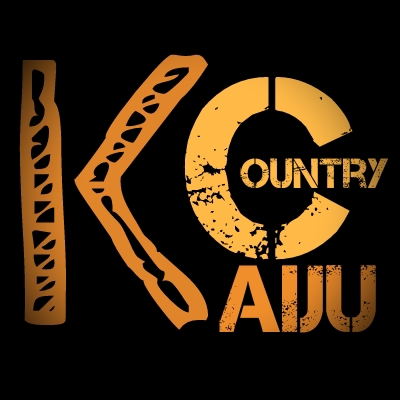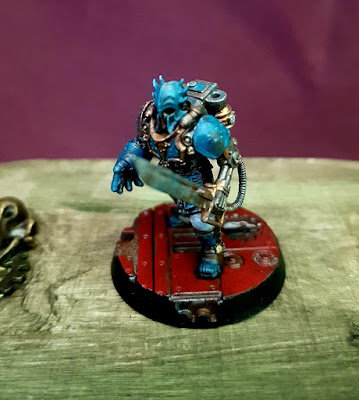Trench-Runner
He's been in production for around 2 months now, but Trench-Runner is finally complete!
Crashing into Corbenic's ocean depths after jumping from a diving platform, Trench-Runner is a Helverin class suit of Armiger Knight armour who specialises in rapid response deployments.
 |
| I feel like I've really captured the feeling of motion by posing the knight with his head and the points of his toes pointing down, while his arms are up at his sides |
 |
| The chains were deliberately positioned in broad loops so that they look as though they're flying up as the suit drops |
 |
| From the side, the splashes look incredibly dynamic! |
 |
| I put a lot of weathering on the platform support as it's been standing in sea water for a long time |
 |
| A close up of the transparent resin splash |
 |
| A gigantic mine / torpedo sits atop the knight suit's carapace. It's definitely going to make a big bang... |
Making dynamic splashes
Making the resin splash for Trench-Runner was actually a lot more complicated than the large resin pour which I did for Quake Hydra (see my last post).
Because the knight would be interacting with the water, I'd have to build the knight and platform first so that I could work out the dimensions and method for creating the splashes.
I haven't included images of this process as it was pretty straightforward. Reposing the knight suit was easy enough, with the feet needing the most alteration to get the toes pointing down towards the water while still remaining flat enough to take the weight of the model.
The platform was made from a sector mechanicus strut and a couple of platform sections from the old sector imperialis set which I cut round to mimic the contour of the base (this is intended to suggest a platform extending beyond the visible miniature base).
I began the splashes by sculpting the shapes from medium grade super sculpey which I patched here and there with a softer grade (the pink areas) as it is easier to shape without deforming the existing splashes. I sculpted footprints where the knight suit would be entering the water and made sure that it fit the base. Note that I made the footprints about 1mm larger to accommodate any shrinkage.
Once I was happy with the sculpt I fired the sculpey then sealed it with basic mod-podge.
The next step in the process was to create a single piece silicon mould of the splash.
As it was to be a single piece mould, I decided to use a glossy flowerpot (which my wife unknowingly donated). Before anything else, I greased the model with a thin liquid oil to make the de-moulding process easier.
I used a large blob of hot glue to stick the splash to the bottom of the plant pot, ensuring that there were no gaps underneath as otherwise the silicon would creep underneath and make it impossible to de-mould.
Having measured the water volume in advance, I mixed up the correct amount of silicone and used the patented 'put in on top of the vibrating dishwasher for a while' to help any bubbles to rise out of the mixture. Anyone who's made a mould like this has grown to detest bubbles as much as traffic wardens.
To make sure that I got all of the detail with a nice even coat, I used an old paintbrush (which is now consigned to the bin) to create a 2-3mm silicon mould skin before I poured the rest of the silicone into the mould.
Again, I tapped and vibrated the pot to remove air bubbles following the main pour. This is not an ideal process, but I've not yet gone down the vacuum chamber route because I just don't make enough casts to make it worthwhile. Maybe that will change in the future, but for now I just shake it baby!
Once the silicone had fully cured, I greased cleaned then re-greased the mould. I then mixed exactly the right amount of resin to fill the mould. Ok, so I actually overestimated it because I forgot to check the volume instead of weight. Stupid mistake really.
Luckily Mudskipper also needed a resin pour on his base, so I really quickly prepared his a basic clay mould, using the excess resin there so as not to waste any! It's a good job I chose a resin with a longer working time and went with a slower cure mix in case I had issues!
After 24 hours I de-moulded the resin splash...
Next up, I fully painted the base and platform before making a mould wall around the base with syrene and hot glue. It's worth noting here that the hot glue slightly deformed the styrene walls, but I could fix any major issues after the base was fully cured.
In order to get the splashes at the correct level, I cut some transparent blue acetate to make a little stand which I then glued to the base. The walls of the mould were made approximately 2mm taller than the stand so that when the splash piece displaced the wet resin it didn't pour out of the mould!
This was the only test fit I made and as everything had been pre-measured, I was happy that it was correct.
I poured the resin into the mould entirely covering the little stand. This time I had measured the required amount of resin by volume using water. Always do this or you run the risk of wasting a lot of expensive resin or needing to mix up smaller batches which never cure as well because the exothermic reaction is partly based on the mix volume.
I then 'dunked' the splashes into the resin pool after jiggling the bubbles out.
And here is the result of the final pour after removing the mould walls.
I had to clean up the edges with wet and dry sandpaper once the resin had fully cured and I then worked back into the splashes with a heavy acrylic medium which eventually dries clear. I also used this on the miniature's feet and the platform struts to make it look wet and keep the knight in place.
All in all, this was a very complicated but satisfying build!
Meet Conga Blue...
Conga Blue is one of my 3 remaining knights to be joining The Court of the Fisher King. As with my other knights, I wanted him to be unique and as I had a lot of interesting components in my knight bits box, decided to try some more radical changes to what was originally a Forgeworld Knight Mageara.
Conga Blue is intended to be an underwater mining specialist, hence he is armed with a Las cutting arm, a giant pneumatic pick (with a mechadendrite drill on the back), two vestigial las cutters under the carapace and a huge grinder array making up part of his mouth and chest.
He also has a crotch mounted pnuematic shear. Because... why not?!
In addition to the weaponry changes, I also heavily modified the rear of Conga Blue's carapace in order to add two really large propellers with guide fins, hinting that he functions more like a giant deep sea sub underwater.
I created two sets of shoulder mounted torpedo launchers instead of using the traditional rocket launcher array as I felt this fit the theme a lot better and made more sense given the suit's primary purpose.
The pick arm was deliberately fashioned to look a little like an anchor - it looks pretty similar to my original sketch. I'm pretty happy with how it turned out as it took a LOT of sanding to get it looking right. I watched the whole of Altered Carbon season 2 while making this one arm....
The grinder mouth would look a little odd on a normal knight, but I think it really works for Conga Blue!
Did someone say Tyranids?!
I love Tyranids. They were the first army I seriously collected and I am a massive fan of the Forgeworld Heirophant sculpted by Tyranid overlord Simon Egan. The only thing which I feel is missing from the current range is an updated version of an old Epic miniature called (plant your tongue into your cheek) the Tyranid Dominatrix:Awkward name aside, I really liked the original Dominatrix model and always felt like it represented some of the best Tyranid virtues:
1). It's a psychic linchpin
2). It's a symbiotic combination of several creatures
3). It's a giant scary monster
So, in order to bring it back up to date, I have started redesigning the creature while still trying to keep some of the original features. I have also decided to come up with a less provocative name at some point...
This initial sketch has some nice plate designs, but I decided it was too chunky as I wanted to move away from the lumbering original and make the beast look a lot more mobile.
This is pretty much where I am with the design at the moment. Note the longer, thinner limbs, huge bio-cannon and the Zoanthrope like mastermind creature embedded in the armoured carapace.
In addition to its large claws, pointy teeth and toxic tail weapon, I've also incorporated another interesting feature into the creature's carapace. The little strawberry seed shapes on the carapace are actually Hormagaunts which are supposed to be hooked into indents in the armour. They use the creature a transport while it uses them as extra ablative armour and a defense against swarming enemies!
Next up is a study of the controller creature. As it's supposed to have a direct line to the Norn queen on the hiveship, it clearly needs to be a psychic creature with a swollen Zoanthrope-esque head and have the option of digesting particularly interesting specimens on the battlefield in the same way as a Malanthrope or Lictor (hence the feeder tentacles).
From the picture, you can see that it's almost entirely fused with the main creature and is never actually intended to separate from it.
The next image is another head study, using some of the Heirophant features.
I will be starting construction on this project fairly soon - stay tuned for updates!

































































